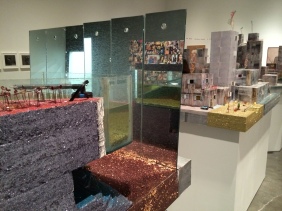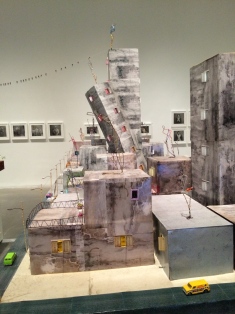Mirrors: Here and Elsewhere
Ici-et-ailleurs (here and elsewhere) is the title of the new exhibition at the New Museum in New York on art from and about the Arab world that I have been to see twice now. The title of the exhibition is taken from the fascinating French documentary of the same title (see video above) by Jean-Pierre Gorin, Jean-Luc Goddard and Anne-Marie Melville.
The documentary made in 1976 is about Palestinian revolutionaries and focuses on the problematic between the image and politics. An issue of course more relevant than ever at the moment and what better place for it than here, New York. There is a lot a material in this exhibition and I am going to focus on one small part, of one small part, of the exhibition, specifically the use of mirrors in Qalandia 2087.
I was really interested in the use of “architectural” models as art pieces in the exhibition (I am thinking a lot about the socio-spatial uses of such models at the moment) and specifically Qalandia 2087 by Wafa Hourani, the third part of a series called the Future Cities (see images of the artwork here).
Hourani has produced an architectural model of a utopian vision of Qalandia one hundred years after the first intifada. Online (here) I found an interesting timeline of Qalandia 2087 by Hourani that I did not see at the exhibition and that seems important to understand the piece. In 1948, following the Nakba, Qalandia became home to thousands of refugees. The name Qalandia comes from a nearby airport of the same name. The Qalandia refugee camp that formed became a pivotal space, located between north Jerusalem and south Ramallah. According to Hourani’s timeline, the year 2087 is when the Mirror Party sign a historic agreement with the new Israeli government and the Palestinians are given the right of return and the 1967 lands back.
Mirrors are important to the piece, and from the information on Hourani’s timeline, have been placed on the Israeli Wall by the Mirror Party “to create the illusion of more space, and seeing their reflection everywhere, begin to wonder how they got in there” and (of course) the mirror has made it into the Guinness Book of Records for the largest mirror in the world. In 2087 when the historic agreement is signed the Wall is not taken down but the cement is taken down and a mirror is fixed to the other side.

Qalandia 2087 by Wafa Hourani
The insertion of mirrors and use of mirrors in this piece reminds me of two pieces and provides interesting connectors to Hourani’s piece and speak to two possible understandings of how this future city ended up with two of the largest mirrors in the world facing opposite each other.
The first is Mumford’s Technics and Civilization where Mumford highlights the introduction of the mirror (glass coated with a silver amalgam) in the sixteenth century and the transformative impact this had on society: “Self-consciousness, introspection, mirror conversation developed with the new object itself: this preoccupation with one’s image comes at the threshold of the mature personality when young Narcissus gazes long and deep into the face of the pool – and the sense of the separate personality, a perception of the objective attributes of one’s identity, grows out of this communion.” This passage resonates with Hourani’s model that is a vision that provides a critique of Palestinian social life, as much as, the Israeli occupation. Later Mumford delivers this: “Indeed, when one is completely whole and at one with the world one does not need the mirror: it is in the period of psychic disintegration that the individual personality turns to the lonely image to see what is in fact is there and what he can hold on to; and it was in the period of cultural disintegration that men began to hold the mirror up to outer nature.”
The other piece of writing that this use of mirrors reminded me of is Eyal Weizman’s chapter in Hollow Land on Checkpoints: The Split Sovereign and the One-Way Mirror. And surprise suprise the chapter features… Qalandia checkpoint! “The upgrade of the Qalandia terminal crossing, which connects (or rather disconnects) Jerusalem from Ramallah, was completed, according to the principles of the Spiegel plan, at the end of 2005. The new system includes a labyrinth of iron fences that channels passengers en route to Jerusalem via a series of turnstiles… The inspection booths are encased in bulletproof glass. The glass is so thick that it tends to reflect the outside light rather than letting it through, thereby obscuring the security personnel inside, and effectively functioning as a one-way mirror”.

